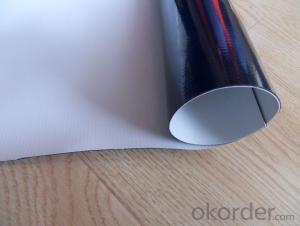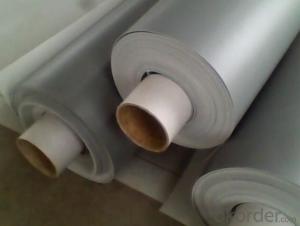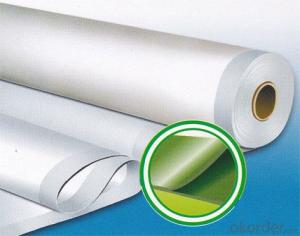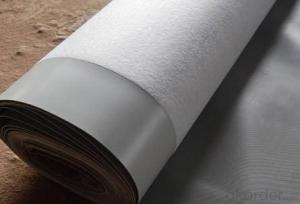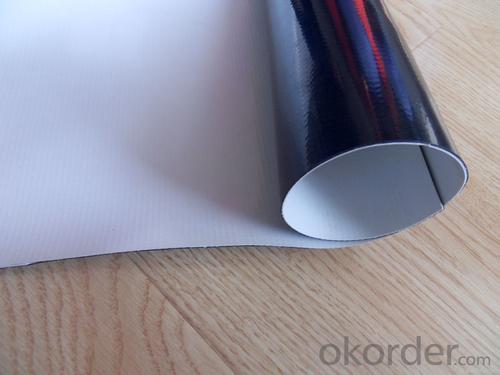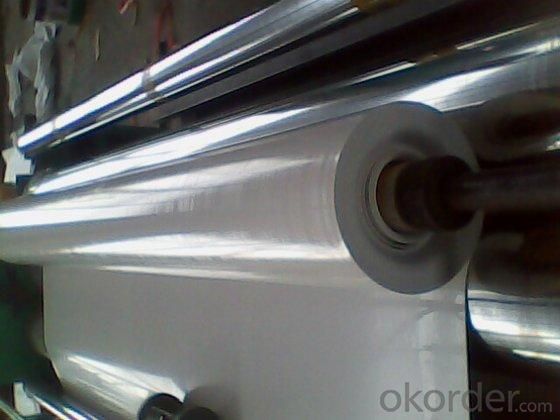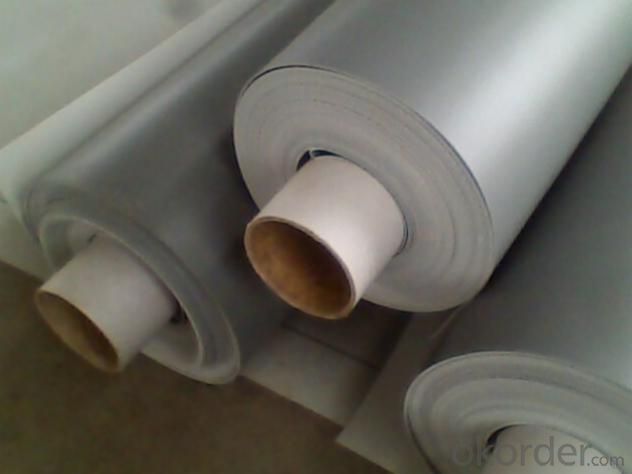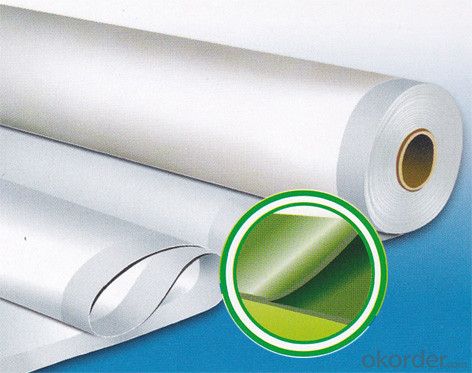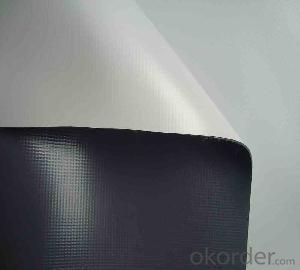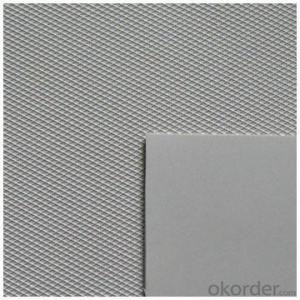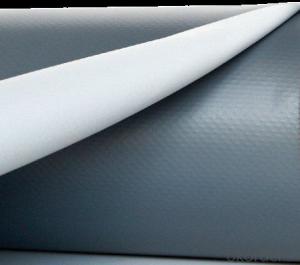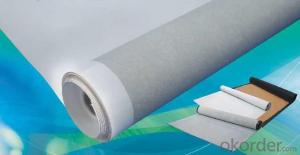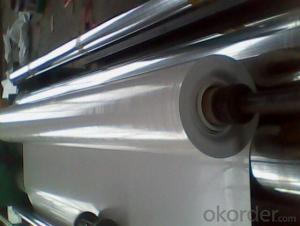PVC Waterproofing Membrane in Polyester Reinforcement in 1.0mm
- Loading Port:
- Shanghai
- Payment Terms:
- TT OR LC
- Min Order Qty:
- 20000 m²
- Supply Capability:
- 5000000 m²/month
OKorder Service Pledge
OKorder Financial Service
You Might Also Like
PVC Waterproofing Membrane in Polyester Reinforcement in 1.0mm
Product Description of PVC Waterproofing Membrane in Polyester Reinforcement in 1.0mm:
PVC Membrane Waterproof /Waterproofing membrane For Roof is a new polymer waterproof membrane. The PVC Membrane Waterproof /Waterproofing membrane For Roof raw material is polyvinyl chloride resin, mixed with plasticizer, filler, antioxygen, ultraviolet absorber and other auxiliaries.
Thickness: 1.2mm/1.5mm/1.8mm/2.0mm
Width:2050mm
Length:20m( Special specifications can be customized)
Size: 2.05mx20m
Color: white/grey, or any other colors.
Features of PVC Waterproofing Membrane in Polyester Reinforcement in 1.0mm:
1. Excellent anti-aging property.
2. Puncture- resistant.
3. Welding construction,
4. High tensile strength, good elongation, good dimensional stability.
5. Good plasticity.
6. It has self-extinguishing from fire property.
7. Materials surface is smooth, fast color, stain resistance.
8. More wide, Wastage become less when being used.
Classification of PVC Waterproofing Membrane in Polyester Reinforcement in 1.0mm:
1. N: Homogeneous PVC membrane
2. L: PVC membrane with fabric backing
3. W: Reinforced PVC membrane
Advantage of PVC Waterproofing Membrane in Polyester Reinforcement in 1.0mm:
1.) Mixing automation. Apply automatic temperature control automatic time control and automatic feed control.
2.) Extrusion equipment uses twin screw coextrusion. Screw temperature uses computer automatic temperature control system.
3.) Handpiece uses large width didhead extrusion equipment.
4.) Sophisticated three-roller calender equipment. The space between equiment is controlled by automation system.
Technical Data of PVC Waterproofing Membrane in Polyester Reinforcement in 1.0mm:
No. | Item | Model Ⅱ | |
1 | Tensile Strength Mpa ≥ | 12.0 | |
2 | Elongation at break% ≥ | 250 | |
3 | Shrinkage rate % ≤ | 2.0 | |
4 | Flexibility at low temperature | No crackle at -25oC | |
5 | Water tightness | Watertight | |
6 | Puncture resistance | Watertight | |
7 | Heat aging treatment | Appearance | Free from bubble, crack, cohesion and void |
Change rate of tensile strength % | +20oC | ||
Change rate of elongation at break | |||
Flexibility at low temperature | No crack at -20oC | ||
8 | Chemical corrosion resistance | Change rate of tensile strength % | +20 |
Change rate of elongation at break | |||
Flexibility at low temperature | No crack at -20oC | ||
9 | Artificial weathering | Change rate of tensile strength % | +20 |
Change rate of elongation at break | |||
Flexibility at low temperature | No crack at -20oC | ||
Application of PVC Waterproofing Membrane in Polyester Reinforcement in 1.0mm:
1) All kinds of roofs, such as steel structure roof, planted roof etc.
2) Underground engineering, such as building basement, subways, tunnels, air raid shelter, etc.
3) Other projects like artificial lake, dam, water reservoir, grain storehouse, etc.
Images of PVC Waterproofing Membrane in Polyester Reinforcement in 1.0mm:
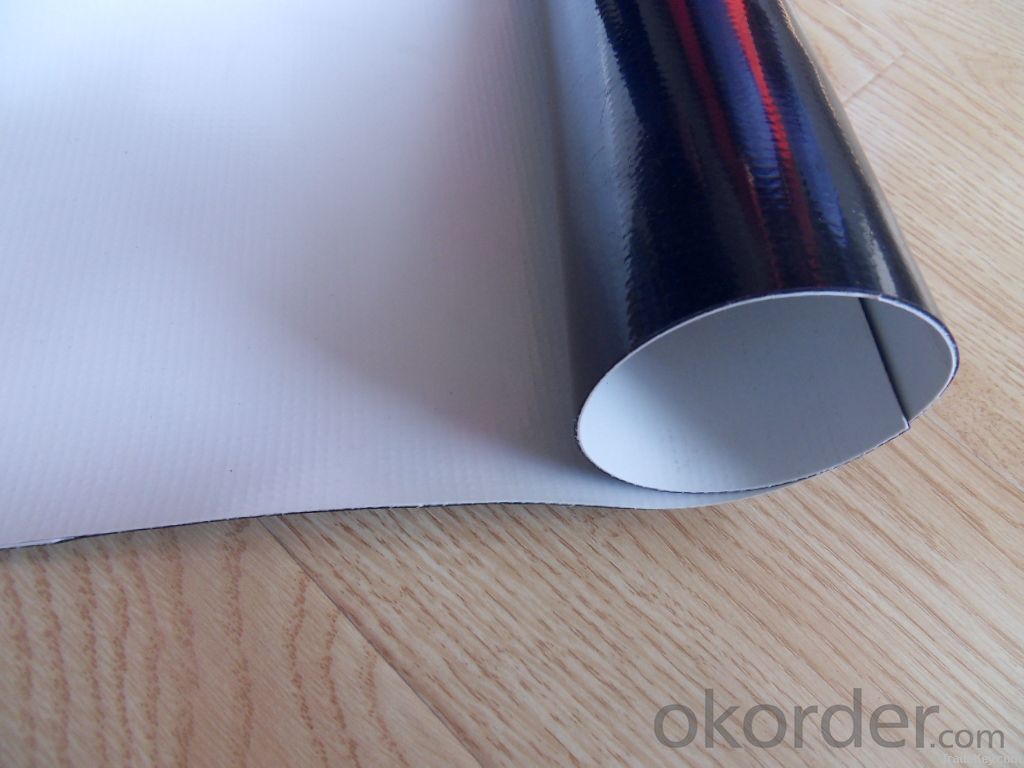
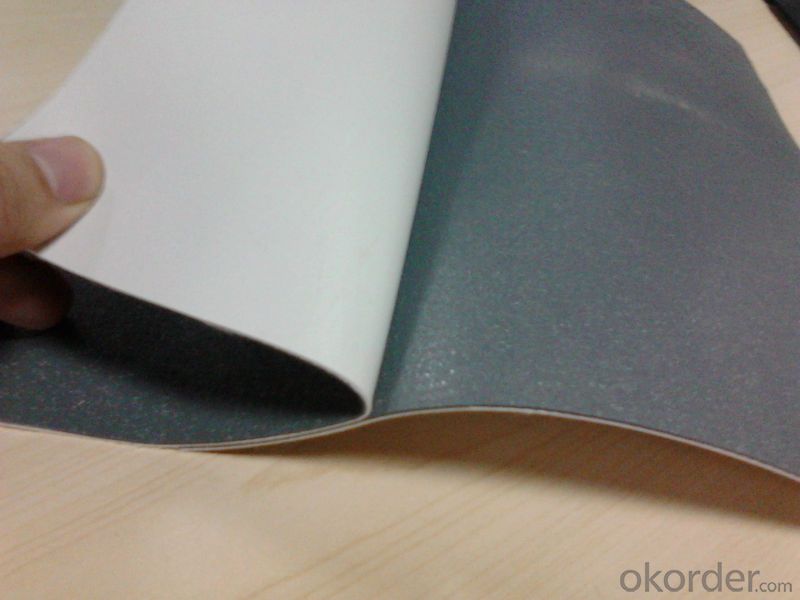
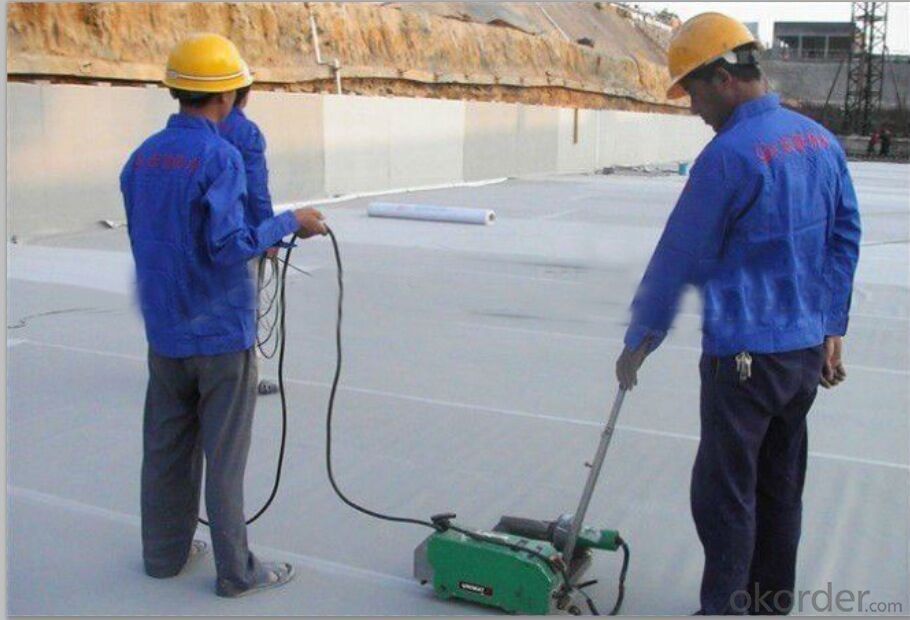
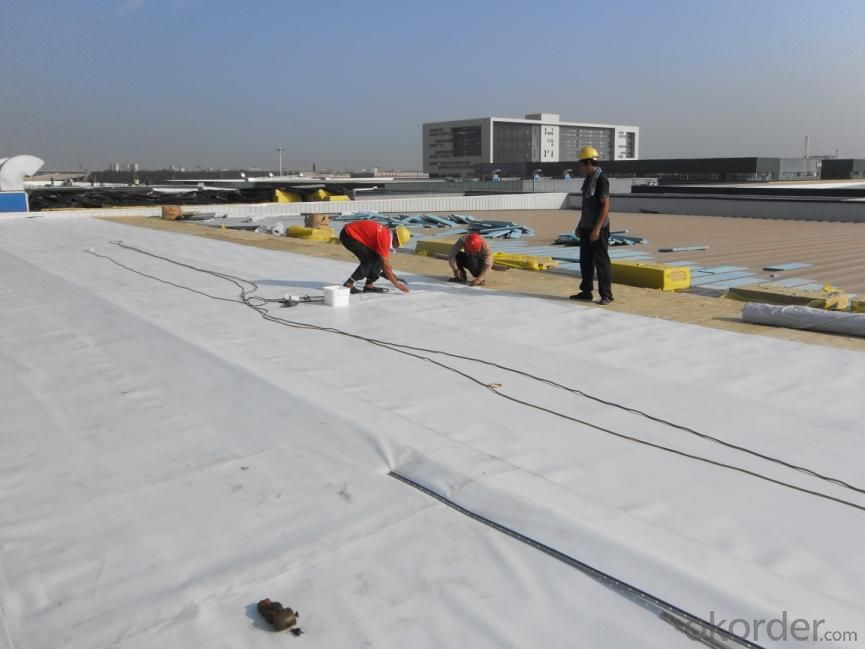
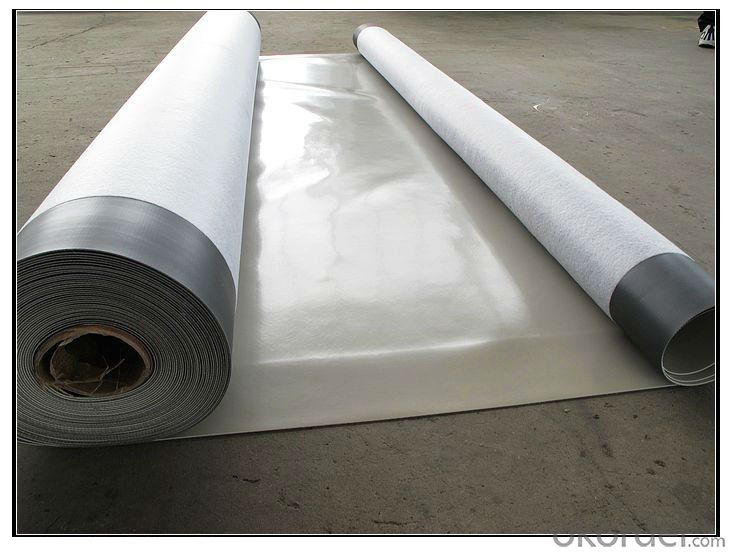
FAQ:
1. Can you produce 4m width?
Yes, no problem for us. We have four bases in China, largest one in this field.
2. How many quantity in one 20'' container for 1.2mm and 1.5mm?
480rolls, 11520m2 for 1.2mm and 400rolls, 9600m2 for 1.5mm
3. Can you provide free samples?
Yes, our samples are free, but express fees usually on buyer's account.
- Q: Can a waterproofing membrane be used in mining or excavation projects?
- Yes, a waterproofing membrane can be used in mining or excavation projects. Waterproofing membranes are designed to prevent the penetration of water or other liquids, making them suitable for protecting underground structures, tunnels, or mining areas from water ingress. They can help to maintain the stability and integrity of the excavation site, preventing water-related damages and ensuring safety.
- Q: Can a waterproofing membrane be applied on top of existing waterproofing systems?
- Yes, a waterproofing membrane can be applied on top of existing waterproofing systems. In some cases, there may be a need to add an additional layer of protection or enhance the existing waterproofing system. Applying a new waterproofing membrane on top can provide an extra barrier against water penetration and help extend the lifespan of the waterproofing system. It is important to ensure proper preparation of the existing surface before applying the new membrane to ensure good adhesion and effectiveness. Additionally, consulting with a professional or manufacturer's guidelines can provide specific recommendations for the compatibility and application process of the new waterproofing membrane.
- Q: Can a waterproofing membrane be used for interior applications?
- Certainly, interior applications can indeed benefit from the use of a waterproofing membrane. Typically employed to avert water infiltration and safeguard structures against moisture-related harm, waterproofing membranes are commonly utilized outdoors, like on roofs, foundations, and basements; however, they can also serve interior purposes. Within interior spaces, it is possible to install waterproofing membranes in areas susceptible to moisture, such as bathrooms, showers, laundry rooms, and kitchens. These membranes effectively establish a barrier against water, thwarting its infiltration into walls, floors, or other structural components. Employing a waterproofing membrane for interior applications affords protection against water damage, mold, and other potential issues stemming from moisture.
- Q: Can a waterproofing membrane be used in residential or commercial structures?
- A waterproofing membrane is suitable for both residential and commercial structures. Its purpose is to establish a barrier that obstructs water from entering the building. These membranes are frequently utilized in areas like basements, foundations, roofs, and bathrooms to safeguard against water damage. In residential structures, they are beneficial in preventing water leaks, mold formation, and structural decay. In commercial structures, they serve to protect valuable assets, such as equipment and inventory, and ensure a safe and healthy environment for employees and customers. Moreover, waterproofing membranes can be applied to both new construction projects and existing structures, making them a versatile solution for any type of building.
- Q: Can waterproofing membranes be applied in cold weather?
- Yes, waterproofing membranes can be applied in cold weather. However, it is important to consider a few factors when applying these membranes in low temperatures. Cold weather can affect the curing process of the membrane, potentially slowing it down. It is crucial to ensure that the surface being waterproofed is dry and free from ice or frost before applying the membrane. Additionally, some waterproofing products may have specific temperature requirements for optimal performance, so it is essential to consult the manufacturer's guidelines. In colder temperatures, it may also be necessary to use specialized adhesives or primers designed for cold weather applications. Overall, with proper precautions and the use of appropriate materials, waterproofing membranes can be successfully applied in cold weather.
- Q: Can a waterproofing membrane be used for storage tanks or containment areas?
- Yes, a waterproofing membrane can be used for storage tanks or containment areas. Waterproofing membranes are designed to provide a barrier against water or other liquid penetration, making them suitable for applications where containment is required. These membranes are typically made from materials such as rubber, PVC, or bitumen, which are known for their water-resistant properties. They can be applied to the interior or exterior surfaces of storage tanks or containment areas to prevent leaks and protect the structures from moisture damage. Additionally, waterproofing membranes can also help to prevent the growth of mold or mildew, ensuring a safe and hygienic environment for stored materials or liquids.
- Q: Can a waterproofing membrane be used on nickel surfaces?
- Yes, a waterproofing membrane can be used on nickel surfaces. Waterproofing membranes are commonly used in construction and building projects to protect surfaces from water damage and moisture intrusion. They create a barrier that prevents water from penetrating through the surface and causing damage. Nickel surfaces, like any other metal surfaces, can be susceptible to corrosion and damage from water exposure. By applying a waterproofing membrane, the nickel surface can be effectively protected from water and moisture, extending its lifespan and maintaining its integrity. However, it is important to ensure that the specific waterproofing membrane being used is suitable for application on nickel surfaces. Different membranes may have different compatibility requirements, so it is recommended to consult with the manufacturer or a professional to ensure proper application and compatibility.
- Q: Can a waterproofing membrane be used on precast galvanized surfaces?
- Yes, a waterproofing membrane can be used on precast galvanized surfaces. The waterproofing membrane is designed to provide a protective barrier against water penetration, and it can be applied to various surfaces including precast galvanized surfaces. The membrane helps to prevent water from seeping into the surface, protecting the underlying structure from moisture damage. However, it is important to ensure that the precast galvanized surface is properly prepared before applying the membrane, as any loose or flaking galvanized coating should be removed to ensure proper adhesion of the membrane. Additionally, it is advisable to consult with the manufacturer or supplier of the waterproofing membrane to ensure that it is compatible with galvanized surfaces and to follow their recommended application guidelines for best results.
- Q: Can a waterproofing membrane be used for a sports facility?
- Indeed, a sports facility can benefit from the utilization of a waterproofing membrane. Its purpose lies in safeguarding structures against water harm by establishing a barrier that effectively obstructs water infiltration. Within a sports facility, where water-related activities like swimming pools, showers, or even outdoor sports fields may occur, a waterproofing membrane presents itself as a valuable solution to maintain a dry environment and shield the structure from water-induced damage. Furthermore, employing a waterproofing membrane can also secure the foundation of the sports facility against water penetration, which, if left unattended, may result in structural complications over time. In summary, the inclusion of a waterproofing membrane in a sports facility not only guarantees its endurance and resilience but also furnishes athletes and visitors with a secure and dry atmosphere.
- Q: Does a waterproofing membrane provide any soundproofing benefits?
- A waterproofing membrane, unfortunately, does not offer any advantages in terms of soundproofing. Its sole purpose is to safeguard surfaces against water infiltration, such as roofs, walls, or foundations. It is typically composed of materials like asphalt, rubber, or polyethylene, which are not effective in obstructing or absorbing sound waves. On the other hand, soundproofing entails the utilization of distinctive materials and techniques that can diminish or eradicate the transmission of sound from one area to another. This may involve insulation, acoustic panels, or soundproof barriers. Consequently, if soundproofing is a concern, it is essential to contemplate separate soundproofing measures in conjunction with a waterproofing membrane.
Send your message to us
PVC Waterproofing Membrane in Polyester Reinforcement in 1.0mm
- Loading Port:
- Shanghai
- Payment Terms:
- TT OR LC
- Min Order Qty:
- 20000 m²
- Supply Capability:
- 5000000 m²/month
OKorder Service Pledge
OKorder Financial Service
Similar products
Hot products
Hot Searches
Related keywords
